【微课视频】初中英语语法MUSIC17
初中英语人教版七年级下册微课课件

A: What did ___ you do yesterday? B: I _____ went to the movie.
A: What did ___ you do last weekend? B: I did ___ my homework.
What did you do ___ last weekend? We ____________________ visited the fire station. How was ___ your trip last weekend? It was boring. do last weekend? What did they ___ Theypicked ______________________ some strawberries. How were ____ the strawberries? They were delicious.
地点 Where did she work last year?
主语 Who worked in a hospital last year?
every day yesterday
• I get home at 5:00 every day. I got home at 5:00 yesterday. • Jack sees a movie every day. Jack saw a movie yesterday. • She buys lunch in the shop every day. She bought lunch in the shop yesterday. • There are many people in our school every day. There were many people in our school yesterday.
初一英语开闭音节
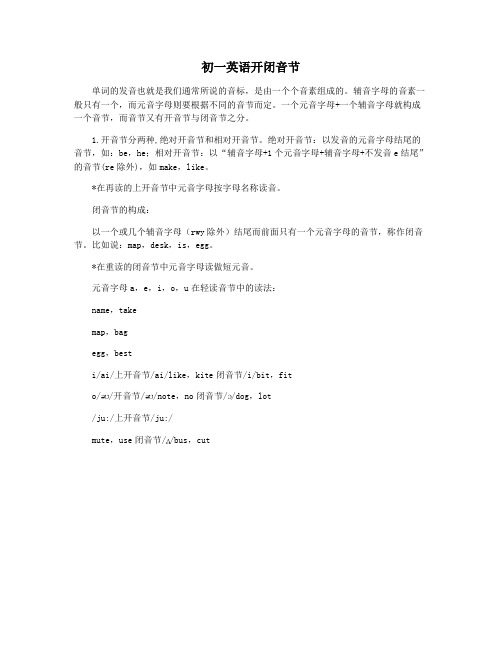
初一英语开闭音节
单词的发音也就是我们通常所说的音标,是由一个个音素组成的。
辅音字母的音素一般只有一个,而元音字母则要根据不同的音节而定。
一个元音字母+一个辅音字母就构成一个音节,而音节又有开音节与闭音节之分。
1.开音节分两种,绝对开音节和相对开音节。
绝对开音节:以发音的元音字母结尾的音节,如:be,he;相对开音节:以“辅音字母+1个元音字母+辅音字母+不发音e结尾”的音节(re除外),如make,like。
*在再读的上开音节中元音字母按字母名称读音。
闭音节的构成:
以一个或几个辅音字母(rwy除外)结尾而前面只有一个元音字母的音节,称作闭音节。
比如说:map,desk,is,egg。
*在重读的闭音节中元音字母读做短元音。
元音字母a,e,i,o,u在轻读音节中的读法:
name,take
map,bag
egg,best
i/ai/上开音节/ai/like,kite闭音节/i/bit,fit
o/əʊ/开音节/əʊ/note,no闭音节/ɔ/dog,lot
/ju:/上开音节/ju:/
mute,use闭音节/ʌ/bus,cut。
新概念英语第二册Lesson17详细教案笔记

【New words and expressions】(5)★appear [əˈpɪə(r)](1)v. 登场,扮演(本文意思)eg. The singer can’t appear tonight because of his illness.这个歌手今晚因为生病不能登台演出了。
(2) v. 出现(反:dis appear 消失)eg. The plane appeared. / The plane disappeared.飞机出现了。
/飞机消失了。
(3) 似乎,看起来好像(系动词,后面必须 + 形容词)eg. He appeared nervous. 他看起来很紧张。
He appeared to know you. 他似乎认识你。
★stage [steɪdʒ] n. 舞台,时期eg. backstage 后台on the stage 在舞台上in the stage 在某一阶段(时期)★bright [braɪt] adj.(1)明亮的(反:dim 昏暗的)eg. What a bright room! 多明亮的一个房间啊!bright eyes 明亮的眼睛bright and early 一大早,一清早look at the bright side往好的方面看,持乐观态度(2)鲜艳的eg. bright red 大红色bright yellow 嫩黄色bright blue 宝蓝色(3)聪明的 = clever(修饰人)★ stocking [ˈstɒkɪŋ] n.(女用)长筒袜★ sock [sɒk] n. 短袜eg. a pair of woolen stockings/socks一双羊毛长袜/短袜【课文讲解】1、My aunt Jennifer is an actress.我的姑姑詹妮弗是位演员。
●形容词性物主代词(后面必须跟名词):my,your,his,her,its, our, your, their●名词性物主代词(后面不能跟名词):mine, yours, his, hers, its, ours, yours,theirs eg. This is my bag. = This bag is mine.●aunt 阿姨,婶婶… (ant 蚂蚁)uncle 叔叔,舅舅… (ankle 脚踝)●act or男演员—— actr ess女演员airhost ess空姐wait er男服务员—— waitr ess女服务员prince 王子—— princ ess公主lion 公狮—— lion ess母狮tig er雄老虎—— tigr ess雌老虎,凶悍的女人2、She must be at least thirtyfive (years old).她至少也有35岁了。
Unit2知识点汇总2024-2025学年(2024)七年级英语上册

新版外研社英语七(上)Unit2 知识点汇总一.词性变化1.fun(n.乐趣;adj.有趣的)——funny(adj.有趣的;滑稽的)2.sound:n.声音v.听起来3.different(adj.不同的)——difference(n.差异)4.sudden(adj.突然的)+ly(副词后缀)=suddenly(adv.突然地)5.feel(v.觉得)+ing(名词后缀)=feeling(n.感觉)6.direct(adj.直接的)+ly(副词后缀)=directly(adv.直接地)7.love(v.爱)去e+er(名词后缀,表示人)=lover(n.爱好者)8.plete(v.竞争)——petition(n.竞争)9.act(v.行动)+ion(名词后缀)=action(n.行为;行动)10.a(形容词前缀)+wake(v.醒来)=awake(adj.醒着的)11.mid(前缀,中间的)+night(n.晚上)=midnight(n.午夜)12.shelf(n.架子)——(pl.shelevs)13.nervous(adj.神经紧张的)+ly(副词后缀)=nervously(adv.焦虑不安地)14.write(v.写)+ing(名词后缀)=writing(n.写作)15.end(v.结束)+ing(名词后缀)=ending(n.结局)二.重点短语1.plant flowers 种花2.ride a bike 骑自行车3.play the violin 拉小提琴4.rock music 摇滚乐5.e out 1. 出来2. 开花3. 出版6.play the electric guitar 弹电吉他7.write songs 写歌8.at this moment 在这时;此刻9.the sound of... ……的声音10.a different kind of... 一种不同类型的……11.a fan of.. 一个……的迷12.put together 组合13.rush into 冲进14.decide to do sth. 决定做某事15.nod to sb. 向某人点头16.fire up 发动(机器),启动(设备)17.take part in=join in 参加某活动18.have great fun 玩得开心19.have interest in 对……感兴趣20.win the first prize 获一等奖21.from then on 从那时起22.start to do sth. 开始做某事23.hundreds of 成百上千的24.take...for example 以……为例25.more and more 越来越多26.fly into 飞进;飞入27.on the ground 在地上28.hold up 举起;抬起29.fly away 飞走30.at the beginning 在开头31.take off 起飞32.take sb. To sp. 带某人去某地33.make a poster 制作海报34.at midnight 在午夜35.tap on the door 轻敲门36.on a shelf 在架子上37.feel a bit lonely 感到有点孤独38.shake one’s head 摇头39.want to do sth. 想要做某事40.make friends 交朋友41.look forward 环顾四周;到处看看42.on Wednesday 在周三三.重点句子1.What is your hobby?你的爱好是什么?2.What do you think of their hobbies?你认为它们的爱好怎么样?3.There is so much fun in music.音乐有很多乐趣。
初一英语44个音标的读法

初一英语44个音标的读法一、元音1.单元音:/i:/:发音时舌尖抵下齿,舌前部尽量抬高,嘴唇向两旁伸开,成扁平形。
例如:bee(蜜蜂)中的“ee”发音。
读音类似汉字“衣”的长音。
/ɪ/:发音时舌尖抵下齿,舌前部抬高,舌位中高,不圆唇。
例如:sit(坐)中的“i”发音。
读音类似汉字“衣”的短音。
/e/:发音时舌尖抵下齿,舌前部稍抬起,唇形稍扁,开口度比 /ɪ/大。
例如:bed(床)中的“e”发音。
读音类似汉字“哎”。
/æ/:发音时舌尖抵下齿,舌前部最低,双唇向两旁平伸,成扁平形。
例如:cat(猫)中的“a”发音。
读音类似汉字“哎”的短而急促音。
/ɑ:/:发音时口张大,舌身压低并后缩,舌尖不抵下齿。
例如:car(汽车)中的“ar”发音。
读音类似汉字“啊”的长音。
/ʌ/:发音时舌尖和舌端两侧轻触下齿,舌后部靠前部分稍抬起,唇形稍扁,开口度较大。
例如:cup(杯子)中的“u”发音。
读音类似汉字“啊”的短音。
/ɔ:/:发音时双唇收得小而圆,并向前突出,舌身往后缩。
例如:all(全部)中的“al”发音。
读音类似汉字“哦”的长音。
/ɒ/:发音时口张大,舌身尽量降低并后缩,双唇稍稍收圆。
例如:hot(热的)中的“o”发音。
读音类似汉字“哦”的短音。
/u:/:发音时舌后部尽量抬起,双唇收圆并突出,口形小而圆。
例如:food(食物)中的“oo”发音。
读音类似汉字“乌”的长音。
/ʊ/:发音时舌后部抬起,双唇收圆,稍突出,比 /u:/ 稍放松些。
例如:book(书)中的“oo”发音。
读音类似汉字“乌”的短音。
/ə/:发音时舌身平放,舌中部微微隆起,双唇扁平。
例如:about (关于)中的“a”发音。
读音类似汉字“呃”。
/ɜ:/:发音时舌身平放,舌中部稍抬起,双唇扁平。
例如:bird (鸟)中的“ir”发音。
读音类似汉字“呃”的长音。
2.双元音:/eɪ/:由/e/向/ɪ/滑动,发音过程中口形由半开到合,舌位由低到高。
七年级上册英语课件unit

七年级上册英语课件u n i tTTA standardization office【TTA 5AB- TTAK 08- TTA 2C】七年级上 Unit 1 My name's Gina.❖语法详解:形容词性物主代词:概念:形容词性物主代词是用来表示所有关系的代词,有人称和数的变化。
用法:①形容词性物主代词不能单独使用,其后必须接名词,即在名词前作定语。
②形容词性物主代词不能与冠词和指示代词连用。
③形容词性物主代词与形容词一起修饰名词时,其顺序应为:形容词性物主代词+形容词+名词。
如:my red pen 我的红色钢笔BE动词一般疑问句Ⅰ:概念:一般疑问句是指可以用Yes或No回答的疑问句。
本单元主要学习be动词的一般疑问句。
结构:Be动词+主语+其他?回答:Yes,主语+be.(肯定回答)/No,主语+be not.(否定回答) 如:—Is he Jim他是吉姆吗—Yes,he is./No,he isn't.是的,他是。
/不,他不是。
be动词可缩写与不可缩写的情况:be动词可缩写的情况①一般am,is,are与前面的名词或代词缩写时,省去前面的元音字母并在省去的地方加“'”。
如:I am→I'm; what is→what's; you are→you're②not与be动词的缩写形式。
如:are not→aren't; is not→isn'tbe动词不可缩写的情况①this is,am not,those/these are都没有缩写形式。
②在一般疑问句的简略回答中,肯定回答时,代词不能与am,is,are缩写。
如:Are you Tom你是汤姆吗正:Yes,I am. 误:Yes,I'm.❖语法专练一、用所给词的适当形式填空。
1.Hello! ___ (I) am 's ______ (you) name?2.Are _____ Jack(you)3.—How are ______—I'm fine,thank _____.(your)4.—What's _____ name?—_____ name is Tom.(he)5.—Is _____ Alice?—No,_____ isn' name's Mary.(she)二、按要求完成句子。
英语人教新目标八年级上册The Simple Past Tense微课

The Simple Past Tense
表示过去的时间状语 yesterday yesterday morning last+时间 last week/year/month 时间+ago two days ago
one year ago
just now in 2000
The Simple Past Tense
4. 特殊疑问句 1)疑问词+was/were 主语+其他? 2)疑问词+did+主语+V原形+其他?
---Where did she go yesterday? ---She went to the school. ---When was she at home? ---Yesterday.
The Simple Past Tense
The Simple Past Tense
Teaching Points
1.一般过去时的定义及构成 2.规则动词和不规则动词过去式的变化
The Simple Past Tense
Simple Past Tense 一般过去时
一般过去时描述在过去时间发生的动作或存在的状态。
Carol took some photos last Sunday. I was happy yesterday.
2. 否定形式: 1) 在行为动词前加didn’t,同时还原行为动词; 2) was/were + not
She didn't go to school yesterday. She wasn't at home yesterday.
The Simple Past Tense
3. 一般疑问句 1) Was/Were+主语+do sth.? 2) Did +主语+do+其他?
英语新概念2 Lesson17 Always Young 同步教学课件
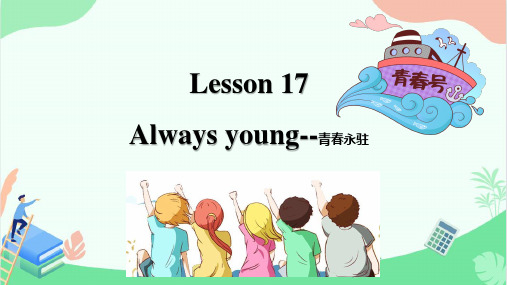
In spite of this, she often appears on the stage as a young girl.
appears as……:扮演……角色(as:作为) appears on the stage as ……:扮演……(扮演的确切表达 ) work as……:最常用于介绍某人是做什么工作的 treat sb / sth as……:把sb/sth当作(看作)…… 例:He appears as a prince. 他扮演王子的角色。
My aunt Jennifer is an actress. She must be at least thirty-five years old. In spite of this, she often appears on the stage as a young girl. Jennifer will have to take part in a new play soon. This time, she will be a girl of seventeen. In the play, she must appear in a bright red dress and long black stockings. Last year in another play, she had to wear short socks and a bright, orange-coloured dress. If anyone ever asked her how old she is, she always answers, 'My dear, it must be terrible to be grown up!
a pair of socks 一双短袜 These pair of socks are beautiful. But I cannot afford them. 这些短袜很漂亮。但是我买不起。
第十七课 Lesson Seventeen_七年级英语教案
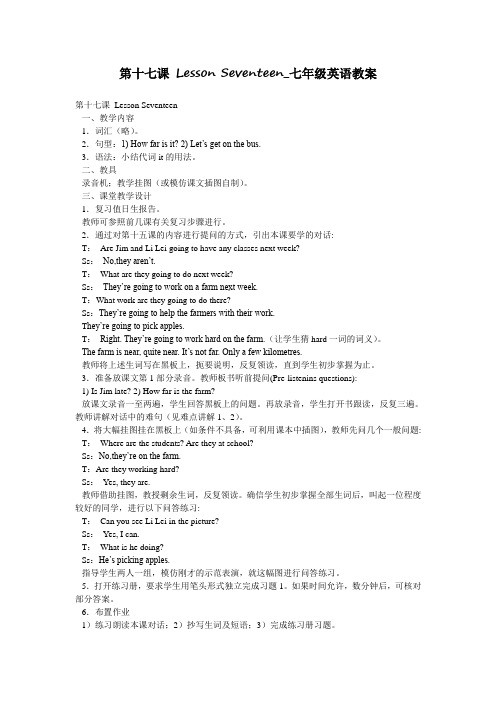
第十七课 Lesson Seventeen_七年级英语教案第十七课Lesson Seventeen一、教学内容1.词汇(略)。
2.句型:1) How far is it? 2) Let’s get on the bus.3.语法:小结代词it的用法。
二、教具录音机;教学挂图(或模仿课文插图自制)。
三、课堂教学设计1.复习值日生报告。
教师可参照前几课有关复习步骤进行。
2.通过对第十五课的内容进行提问的方式,引出本课要学的对话:T:Are Jim and Li Lei going to have any classes next week?Ss:No,they aren’t.T:What are they going to do next week?Ss:They’re going to work on a farm next week.T:What work are they going to do there?Ss:They’re going to help the farmers with their work.T hey’re going to pick apples.T:Right. They’re going to work hard on the farm.(让学生猜hard一词的词义)。
The farm is near, quite near. It’s not far. Only a few kilometres.教师将上述生词写在黑板上,扼要说明,反复领读,直到学生初步掌握为止。
3.准备放课文第1部分录音。
教师板书听前提问(Pre-listenins questions):1) Is Jim late? 2) How far is the farm?放课文录音一至两遍,学生回答黑板上的问题。
再放录音,学生打开书跟读,反复三遍。
教师讲解对话中的难句(见难点讲解1、2)。
4.将大幅挂图挂在黑板上(如条件不具备,可利用课本中插图),教师先问几个一般问题: T:Where are the students? Are they at school?Ss:No,they’re on the farm.T:Are they working hard?Ss:Yes, they are.教师借助挂图,教授剩余生词,反复领读。
九年级全一册英语七单元2d知识点
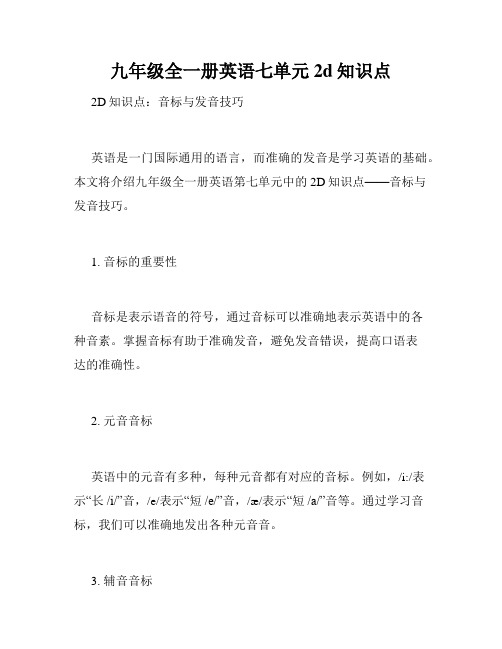
九年级全一册英语七单元2d知识点2D知识点:音标与发音技巧英语是一门国际通用的语言,而准确的发音是学习英语的基础。
本文将介绍九年级全一册英语第七单元中的2D知识点——音标与发音技巧。
1. 音标的重要性音标是表示语音的符号,通过音标可以准确地表示英语中的各种音素。
掌握音标有助于准确发音,避免发音错误,提高口语表达的准确性。
2. 元音音标英语中的元音有多种,每种元音都有对应的音标。
例如,/i:/表示“长/i/”音,/e/表示“短/e/”音,/æ/表示“短/a/”音等。
通过学习音标,我们可以准确地发出各种元音音。
3. 辅音音标与元音不同,辅音通常由两个或更多的音素组合而成。
例如,/p/是一个爆破音,/s/是一个摩擦音,/m/是一个鼻音等。
每个辅音音标都有其独特的发音方式,学习音标可以帮助我们准确发出各种辅音音。
4. 发音技巧除了掌握音标,还有许多发音技巧可以帮助我们改善英语口语。
首先是舌位的正确运用。
舌位对于发出清晰的辅音非常重要。
例如,/t/音是舌尖轻触上齿龈,/k/音是舌后抵住软腭。
正确的舌位可以确保发音准确。
其次是发音的连贯性。
在英语中,连读和变调是非常常见的现象。
通过练习连读和变调,我们可以让英语听起来更加流畅自然。
另外,练习发音时还需要注意音调的变化。
英语中的重音和升降调对于理解和交流非常重要。
通过模仿母语者的发音,我们可以更好地掌握英语的音调。
5. 音标的实践应用学习音标不仅仅是为了在课堂上发音准确,更重要的是为了实际应用。
我们可以通过听录音、看电影、听英语歌曲等方式来巩固和提高自己的发音水平。
此外,互动练习也对于提高发音技巧至关重要。
可以找一位听力好的伴侣,相互进行发音练习和纠正,这样可以更好地锻炼自己的发音能力。
总之,音标与发音技巧是学习英语的重要基础。
通过掌握音标,我们可以准确地发出各种音,提高英语口语的准确性。
此外,通过实践应用和互动练习,我们可以更好地运用所学的知识,提高自己的发音水平。
中学生百科英语1-U4-L1-Music and Behavior

Unit 4 MusicLesson 1 Music and BehaviorWhere did you go yesterday? Did you hear music at any of those places? There is a good chance that you did. Today most stores and restaurants play music. You might even hear music in an office or on a farm.Scientists believe that music affects the way people behave. According to some scientists, the sound of western classical music (Mozart and Bach) makes people feel richer. When a restaurant plays classical music, people spend more money on food and drinks. When the restaurant plays modern music, people spend less money. With no background music, people spend even less.Scientists also believe that loud, fast music makes people eat faster. People actually chew their food faster when the music gets faster. Some restaurants play fast music during their busy hours. This gets people to eat faster and leave quickly. Restaurants can make more money this way.Some scientists think that music makes you think and learn better. They say that music helps students to be more alert. It is true that people learn better when they are relaxed. And listening to music can help you relax.The next time you hear music somewhere, be careful. It might change the way you behave. (202words)Vocabulary①Put the right word in each blank. The sentences are from the text.1. Studies also show that _______________, fast music makes people eat faster.2. You might even hear music in an _________________ or on a farm.3. The next time you hear music somewhere, be ______________.4. According to some scientists, the sound of western _____________ music (Mozart and Bach) makes people feel richer.5. Did you hear ______________ at any of these places?6. When a restaurant plays classical music, people ___________ more money on food and drinks.7. With no _________________ music, people spend even less.8. People actually _______________ their food faster when the music gets faster.9. Scientists believe that music ______________ the way people ______________.10. It ______________ change the way you behave.②Put the right word in each blank. These are new sentences for words in the text.1. You should _______________ your food well. You don't want to get a stomachache.2. Her ____________ is very small. There is only a desk and a chair in it3. The children can't go to the movies this week because they didn't ___________ well at school.4. We couldn't study because there was a loud noise in the ______________.5. What is your favorite kind of ______________?6. You should be _________ when you drive your car.7. _____________________music can hurt your ears.8. Laughter can ________________ your feelings. Usually it makes you feel better.9. She ___________ £100 on a new dress.10. He ___________ get there in time, but I can't be sure.单词默写:1. 影响2. 表现3. 据(…所说)4. 古典的5. 花费金钱/时间在…上6. 背景7. 喧闹的; 大声的8. 咀嚼;嚼碎9. 音乐10.警觉的;警惕的11. 在某处;到某处12.可能翻译句子:1.我通常花半个小时做英语作业。
奇速英语北师大版初中9年级全册Unit 3同步微课教案
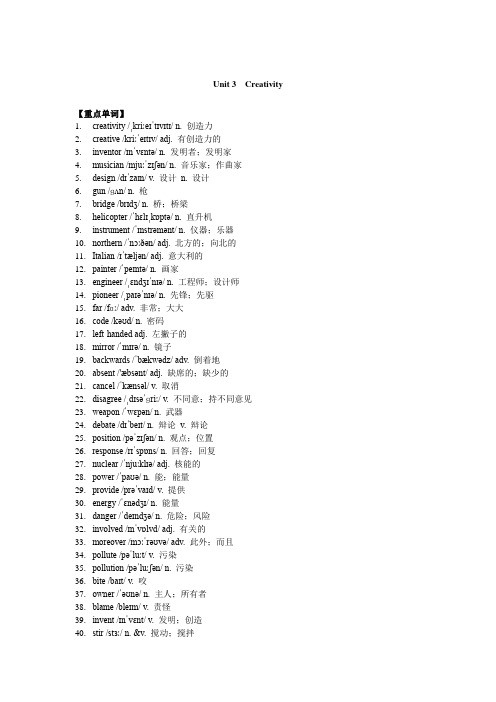
Unit 3 Creativity【重点单词】1.creativity /ˌkriːeɪˈtɪvɪtɪ/ n. 创造力2.creative /kriːˈeɪtɪv/ adj. 有创造力的3.inventor /ɪnˈvɛntə/ n. 发明者;发明家4.musician /mjuːˈzɪʃən/ n. 音乐家;作曲家5.design /dɪˈzaɪn/ v. 设计n. 设计6.gun /ɡʌn/ n. 枪7.bridge /brɪdʒ/ n. 桥;桥梁8.helicopter /ˈhɛlɪˌkɒptə/ n. 直升机9.instrument /ˈɪnstrəmənt/ n. 仪器;乐器10.northern /ˈnɔːðən/ adj. 北方的;向北的11.Italian /ɪˈtæljən/ adj. 意大利的12.painter /ˈpeɪntə/ n. 画家13.engineer /ˌɛndʒɪˈnɪə/ n. 工程师;设计师14.pioneer /ˌpaɪəˈnɪə/ n. 先锋;先驱15.far /fɑː/ adv. 非常;大大16.code /kəʊd/ n. 密码17.left-handed adj. 左撇子的18.mirror /ˈmɪrə/ n. 镜子19.backwards /ˈbækwədz/ adv. 倒着地20.absent /'æbsənt/ adj. 缺席的;缺少的21.cancel /ˈkænsəl/ v. 取消22.disagree /ˌdɪsəˈɡriː/ v. 不同意;持不同意见23.weapon /ˈwɛpən/ n. 武器24.debate /dɪˈbeɪt/ n. 辩论v. 辩论25.position /pəˈzɪʃən/ n. 观点;位置26.response /rɪˈspɒns/ n. 回答;回复27.nuclear /ˈnjuːklɪə/ adj. 核能的28.power /ˈpaʊə/ n. 能;能量29.provide /prəˈvaɪd/ v. 提供30.energy /ˈɛnədʒɪ/ n. 能量31.danger /ˈdeɪndʒə/ n. 危险;风险32.involved /ɪnˈvɒlvd/ adj. 有关的33.moreover /mɔːˈrəʊvə/ adv. 此外;而且34.pollute /pəˈluːt/ v. 污染35.pollution /pəˈluːʃən/ n. 污染36.bite /baɪt/ v. 咬37.owner /ˈəʊnə/ n. 主人;所有者38.blame /bleɪm/ v. 责怪39.invent /ɪnˈvɛnt/ v. 发明;创造40.stir /stɜː/ n. &v. 搅动;搅拌41.treat /triːt/ n. 乐趣;乐事42.ice-skate v. 滑冰43.cover /ˈkʌvə/ v. 盖;覆盖44.thinking /ˈθ ɪŋkɪŋ/ n. 思考45.wire /waɪə/ n. 金属丝46.sew /səʊ/ v. 缝;做针线活47.fur /fɜː/ n. (动物的)皮毛;软毛48.steel /stiːl/ n. 钢49.broken /ˈbrəʊkən/ adj. 破损的;出了毛病的50.tube /tjuːb/ n. 管;管子51.fit /fɪt/ v. 可容纳;适合52.tightly /ˈtaɪtlɪ/ adv. 紧紧地53.wrist /rɪst/ n. 手腕54.business /ˈbɪznɪs/ n. 公司;生意55.run /rʌn/ v. 经营;跑ser /ˈleɪzə/ n. 激光57.typesetting /'taipsetiŋ/ n. 排版58.developer /dɪˈvɛləpə/ n. 开发者;研制者59.publishing /ˈpʌblɪʃɪŋ/ n. 出版60.industry /ˈɪndəstrɪ/ n. 产业;工业61.modern /ˈmɒdən/ adj. 当代的;现代的【重点短语】1.adding machine 计算器2.as well as 也3.either way 不管怎样4.cut down 减少;砍倒5.traffic jan 堵车e up with 想出7.work in a team 齐心协力;团队合作8.because of 因为9.far ahead of 遥遥领先10.hundreds of 数以百计的;许多11.work out 解决;算出;实现;制定出12.keep...a secret 保密13.musical instrument 乐器14.catch a cold 感冒15.nuclear power 核能16.deal with 处理17.look after 照顾18.have more advantages than disadvantages 利大于弊19.by accident 偶然;意外地20.have a hard time 过得困难21.as we all know 众所周知22.as a result 结果23.give up 放弃24.be helpful to 对……有帮助25.follow one’s dream 追求梦想26.try one’s best to do sth 尽全力做某事e true 使……成真【重点句型】1.He is considered one of the greatest painters of all time.他被认为是有史以来最伟大的画家之一。
惠州市第七中学七年级英语下册 Module 12 Western music知识梳理外研版

Module 12【重点短语】1。
Beijing Opera 京剧2。
the capital of Austria 奥地利首都3。
think about 认为,考虑4。
pop music 流行音乐5。
Western Music 西方音乐 6. dance to 随着…跳舞7. the center of …的中心8。
European classical music 欧洲古典音乐9。
on the river 在…河畔10。
hundreds of wonderful pieces of music 数以百计的美妙的乐曲11. play music 演奏音乐12. traditional music 传统音乐13. take place 发生14. at the same time 同时15。
watch it on TV 在电视上观看16。
types of music 音乐的类型17. the rest of 其余的。
.。
18。
in the last ten years 在过去的十年里19. at that time 在那时【重点句子】1。
This is Western music, isn't it?这是西方音乐,是吧?2.—Is this by Strauss or Mozart? 这是斯特劳斯还是莫扎特的作品?—It’s by Strauss。
它是斯特劳斯的作品。
3。
Do you know anything about him?你了解他吗?4。
What a beautiful city!多么美丽的城市!5。
This is called The Blue Danube。
这首乐曲叫[蓝色多瑙河]。
6。
It goes through Vienna。
它流经维也纳。
7. Listen to this fantastic voice。
你听这绝妙的嗓音。
8. I'm a fan of rock music. 我是一个摇滚乐迷。
Lesson 17 课件 冀教版英语七年级下册
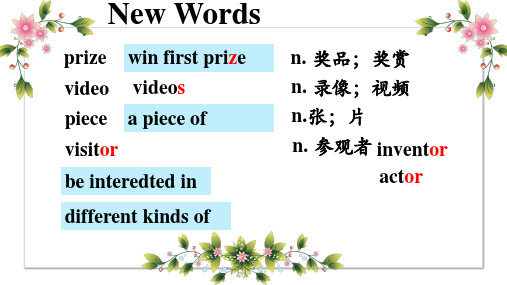
Jenny’s project is about silk worms and Danny’s project is about donuts.
3.What did Jenny make for her project??
She made a video. 4.What does Danny think of silk worms?
这个男孩曾经w对as数in学te感re兴ste趣d 。in Once the boy ______________ math. 你对弹吉他感兴趣吗?playing Are you interested in ________ (play) the guitar?
4. I have a small piece of old silk. 我有一块旧丝绸。 a piece of 一张, 一片( 可修饰不可数名词)
She has a small piece of old silk. She also has a silk worm for the visitors.Danny’s project is all about donuts. He will make 10 different kinds of donuts!
New Words
prize win first prize video videos piece a piece of visitor be interedted in different kinds of
n. 奖品;奖赏 n. 录像;视频 n.张;片 n. 参观者 inventor
actor
NiLghetsFsaoirn(夜1F市7low)SecrhFoaoirl(花展Sc) ience Fair(科学展会)
初高中英语衔接--48个国际音标发音 带音频课件

/w/
例词:
week whale win window
短语:
weight watcher weave a web weeping willow wet wind
/ts/
students coats cats boats
/dz/
heads reads beds hands
/tr/
tree truck train trace
/ɪ/- /i/
例词:
pin ship
短语:
a big ship Miss Smith
hill chicks
fifty pictures interesting films
/e/
例词:
pen head
短语:
ten pence expensive cigarettes
leg well
very well went to America
/eǝ/-/εǝ/
例词:
hair bare pear
短语:
millionaire’s heir mayor’s parents square chairs careful librarian
chair
/ʊǝ/-/vǝ/
例词:
tour poor
短语:
poor tourists furious jury
单元音双元音辅音爆破音鼻音半元音舌边音trdrtsdzvowelspurevowelsheseatreefield短语
IPA-International Phonetic Alphabet
国际音标
国际音标
英语中共有48个音标,元音20个,辅音28个。
单元音 元 音{
/i:/, /ɪ/, /e/, /æ/ /ɜ:/, /ǝ/, /ʌ/ /u:/, /ʊ/, /ɔ:/, /ɒ/, /ɑ:/
七年级英语语音知识点仁爱
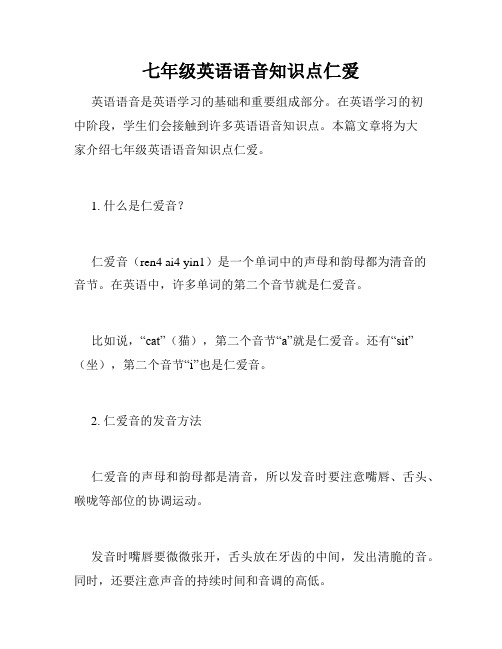
七年级英语语音知识点仁爱英语语音是英语学习的基础和重要组成部分。
在英语学习的初中阶段,学生们会接触到许多英语语音知识点。
本篇文章将为大家介绍七年级英语语音知识点仁爱。
1. 什么是仁爱音?仁爱音(ren4 ai4 yin1)是一个单词中的声母和韵母都为清音的音节。
在英语中,许多单词的第二个音节就是仁爱音。
比如说,“cat”(猫),第二个音节“a”就是仁爱音。
还有“sit”(坐),第二个音节“i”也是仁爱音。
2. 仁爱音的发音方法仁爱音的声母和韵母都是清音,所以发音时要注意嘴唇、舌头、喉咙等部位的协调运动。
发音时嘴唇要微微张开,舌头放在牙齿的中间,发出清脆的音。
同时,还要注意声音的持续时间和音调的高低。
3. 练习仁爱音的方法要想掌握仁爱音的发音,需要进行反复的练习。
这里介绍几种练习方法,帮助大家更好地掌握仁爱音的发音。
方法一:模仿大声地模仿老师或者录音中的发音。
多听多模仿,可以帮助我们更好地感受发音的节奏和语调,从而更好地发音。
方法二:口型练习法通过练习不同的口型,可以帮助我们更好地掌握仁爱音的发音。
比如说,练习发“e”音时,可以将嘴唇微微张开,语调高一些;练习发“i”音时,可以让舌头靠近牙齿,语调低一些。
方法三:连词练习法通过练习连词,可以提高我们的发音速度和连贯性。
比如说,练习“it is”(它是),可以反复练习“it”和“is”两个单词的发音,然后将它们连起来。
4. 总结仁爱音是英语中非常常见的一种音节。
掌握仁爱音的发音方法,需要进行反复的听、说、读、写的练习。
通过不断的练习,我们可以更好地掌握仁爱音的发音技巧,提高我们的英语口语水平。
